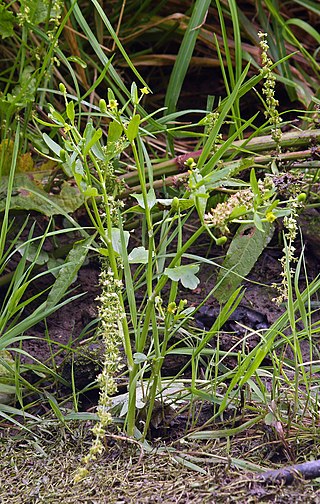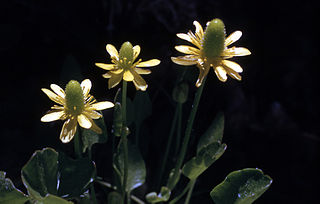
Ranunculus is a large genus of about 1700 to more than 1800 species of flowering plants in the family Ranunculaceae. Members of the genus are known as buttercups, spearworts and water crowfoots.

Ranunculus pygmaeus, the pygmy buttercup or dwarf buttercup, is a species of buttercup found throughout the Arctic, as well as in the mountains of Norway and the Rocky Mountains. A few populations also exist in the Eastern Alps and Tatra Mountains.

Ranunculus bulbosus, commonly known as bulbous buttercup or St. Anthony's turnip, is a perennial flowering plant in the buttercup family Ranunculaceae. It has bright yellow flowers, and deeply divided, three-lobed long-petioled basal leaves.

Ranunculus acris is a species of flowering plant in the family Ranunculaceae, and is one of the more common buttercups across Europe and temperate Eurasia. Common names include meadow buttercup, tall buttercup, common buttercup and giant buttercup.

Ranunculus sceleratus known by the common names celery-leaved buttercup, celery-leaf buttercup, and cursed buttercup is a species of flowering plant in the buttercup family Ranunculaceae. It has a circumpolar distribution in the northern hemisphere, native to temperate and boreal North America and Eurasia, where it grows in wet and moist habitats, including ponds and streambanks.

Ranunculus gmelinii, Gmelin's buttercup or small yellow water-crowfoot, is a species of flowering plant in the buttercup family, Ranunculaceae. It is native to northern North America, where it occurs across Canada and the northern and higher-elevation regions of the United States. It is also present in Eurasia.

Ranunculus alismifolius is a species of buttercup known by the common name plantainleaf buttercup. It is native to western North America from British Columbia to California to Colorado, where it grows in moist mountain habitat such as meadows, streambanks, and bogs, becoming common to abundant in some places. It is somewhat variable in appearance and there are several varieties which can be hard to tell apart. In general the plant is a perennial herb producing a few usually upright to erect, branching stems from a fleshy, fibrous root system. It can be up to half a meter tall, or it can remain quite short and clumpy. The leaves vary in shape, the lower ones with oval blades and the upper linear to lance-shaped, all borne on long petioles. The inflorescence bears one or more flowers, each on a long pedicel. The flower has up to 12 yellow petals and many yellow stamens and pistils at the center. The fruit is an achene, borne in a spherical cluster of 12 or more.
Ranunculus canus is a species of buttercup known by the common name Sacramento Valley buttercup. It is endemic to California, where it grows in the Central Valley and adjacent mountain foothills, and the Transverse Ranges just south. It grows in grassland and meadows in woodland and forest habitat. This plant can be very similar in appearance to the California buttercup, and may be difficult to distinguish from it. It is variable in form. In general the plant is a perennial herb producing erect, usually hairy stems up to 65 centimeters tall. The hairy leaves are each made up of three leaflets, leaves occurring lower on the plant with wider leaflets which may be notched to lobed, and upper leaves with narrow, toothed leaflets. The flower has up to 23 shiny yellow petals and many yellow stamens and pistils at the center. The fruit is an achene, borne in a spherical cluster of 11 or more.

Halerpestes cymbalaria is a species of buttercup known by the common names alkali buttercup and seaside buttercup. It is native to much of Eurasia and parts of North and South America, where it grows in many types of habitat, especially in moist to wet areas such as marshes, bogs, and moist spring meadows. It is a perennial herb producing several stems a few centimeters to nearly 40 centimeters long. Some are prostrate against the ground and are stolons which root in moist substrate, and some are erect. The leaves are variable in shape, the basal ones with notched or slightly divided leaf blades borne on long petioles, and any upper leaves much reduced in size. The inflorescence bears one or more flowers on erect stalks. The flower has five to eight pale yellow petals, each under a centimeter long. The protruding receptacle at the center of the flower becomes a cylindrical cluster of fruits, each of which is an achene.

Ranunculus eschscholtzii is a species of buttercup flower known by the common name Eschscholtz's buttercup.
Ranunculus gormanii is a species of buttercup known by the common name Gorman's buttercup. It is native to Oregon and northern California, where it grows in the Klamath Mountains and a section of the southern Cascade Range. It can be found in moist areas in mountain forests and meadows. It is a perennial herb producing prostrate stems which extend along the ground up to 20 centimeters in length, sometimes rooting at nodes that come in contact with wet substrate. The leaves have oval blades up to 4 centimeters wide which are borne on petioles up to 7 centimeters in length. Flowers have 5 to 7 shiny yellow petals each a few millimeters long and many stamens and pistils. The fruit is an achene borne in a spherical cluster of up to 15.

Ranunculus hebecarpus is a species of buttercup known by the common name delicate buttercup. It is native to western North America, including several of the western United States and Baja California, where it grows in grassland, woodland, and chaparral habitat. It is an annual herb producing a slender, hairy stem a few centimeters high or up to 30 centimeters tall. The hairy leaves are borne on long petioles. Their blades are deeply lobed or divided into three leaflets, often with toothed or lobed edges. Flowers have 3 to 5 tiny yellow petals just 1 or 2 millimeters long studded on the bulbous nectary; some flowers lack petals. The plant is most easily identified in its fruiting stage, when the infructescence is a spherical cluster of several tiny disc-shaped achenes with compressed, bristly sides.
Ranunculus hydrocharoides is a species of buttercup known by the common names frogbit buttercup, or frog's-bit buttercup. It is native to western North America, including the southwestern United States and Mexico. It is also known from Guatemala. It is aquatic or semi-aquatic, growing floating in water or in wet land near water. Typical habitat includes marshes, streams, and lakes. Stems are up to 25 centimeters long, prostrate on the ground when terrestrial, or floating when aquatic. The shiny green leaves have heart-shaped or oval blades up to 3 centimeters long which are borne on petioles which may be 15 centimeters in length. Flowers have 5 to 8 shiny yellow petals a few millimeters long with many stamens and pistils at the center. The fruit is an achene borne in a spherical cluster of 9 or more.

Ranunculus muricatus is a species of buttercup known by the common names rough-fruited buttercup and spinyfruit buttercup. It is native to Europe, but it can be found in many other places in the world, including parts of Africa, Australia, and the western and eastern United States, as an introduced species and agricultural and roadside weed. It grows in wet habitats, such as irrigation ditches. It is an annual or sometimes biennial herb producing a mostly hairless stem up to half a meter long which may grow erect or decumbent along the ground. The leaves have blades a few centimetres in length which are deeply divided into three lobes or split into three leaflets. They are hairless to hairy in texture, and are borne at the tips of long petioles. The flower has five shiny yellow petals under 1 centimetre (0.4 in) long around a lobed central receptacle studded with many stamens and pistils. The fruit is a spiny achene borne in a spherical cluster of 10 to 20.

Ranunculus parviflorus is a species of buttercup known by the common name smallflower buttercup. It is native to Europe, but it is known on other areas of the world as an introduced species and sometimes a roadside weed, for example, in parts of Australia and the United States.
Ranunculus populago is a species of buttercup known by the common names popular buttercup and mountain buttercup. It is native to the Pacific Northwest and surrounding areas in the United States, where it grows in wet habitat, such as bogs, streambanks, and moist mountain meadows. It is a perennial herb producing an upright, mostly hairless stem up to about 30 centimeters in maximum height. Leaves have oval blades borne on long petioles. The flower has usually five or six shiny yellow petals each a few millimeters long around a central nectary and many stamens and pistils. The fruit is an achene borne in a spherical cluster.

Ranunculus sardous is a species of buttercup known by the common name hairy buttercup. It is native to Europe and it can be found in many other areas of the world, including parts of the United States and Australia, as an introduced species and a roadside and lawn weed. It grows in many types of disturbed habitat, especially in moist areas. It is an annual or biennial herb producing a mostly erect, hairy stem up to half a meter tall. The hairy leaves are usually divided into three leaflets which are borne on petioles a few centimeters in length. The flower has usually five yellow petals each up to a centimeter long and five reflexed sepals. The fruit is an achene borne in a spherical cluster of up to 35.

Ranunculus uncinatus is a species of buttercup known by the common names woodland buttercup and little buttercup. It is native to western North America from Alaska to California to New Mexico, where it grows in wet, wooded habitat such as forest streambanks. It is a perennial herb producing a slender, erect stem which may exceed half a meter in maximum height. The lightly hairy lower leaves have blades deeply divided into three toothed lobes borne on long petioles. The upper leaves are smaller and divided into narrower lobes. The flower has four or five yellow petals a few millimeters long around a central receptacle and many stamens and pistils. The fruit is an achene borne in a spherical cluster.

Ranunculus auricomus, known as goldilocks buttercup or Greenland buttercup, is a perennial species of buttercup native to Eurasia. It is a calcicole typically found in moist woods and at the margins of woods. It is apomictic, and several hundred agamospecies have been recognised.

Ranunculus fascicularis, commonly called early buttercup, is a species of flowering plant in the buttercup family (Ranunculaceae). It is native to the eastern North America, where it is found in Canada and the United States. It is generally widespread in eastern North America, although its populations become sporadic in areas east of the Appalachian Mountains and south of New England. Its natural habitat is in dry areas with sparse vegetation, such as rocky or sandy bluffs, prairies, and savannas.
















